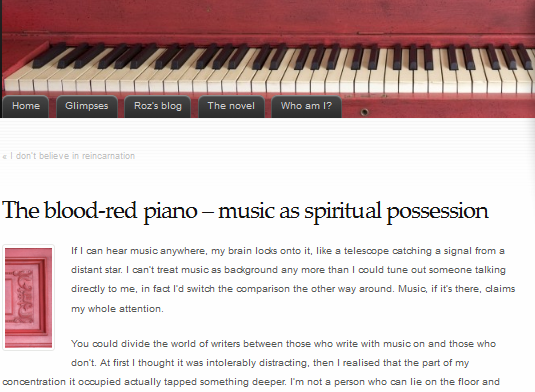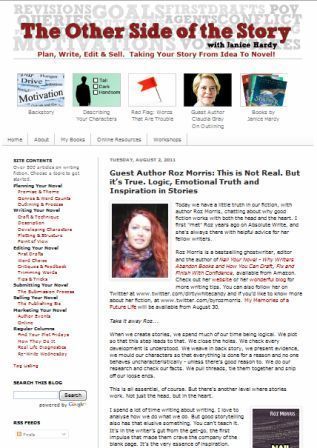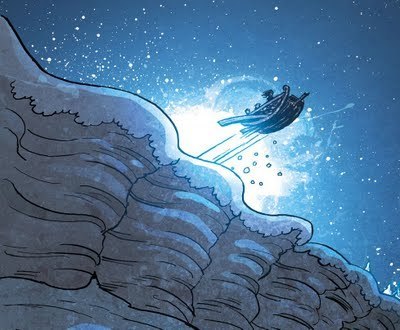Roz Morris's Blog, page 108
August 15, 2011
Music as a form of spiritual possession… and other matters
 Over at the red home of My Memories of a Future Life I've been a bit more active than I anticipated. I've been writing material to put up nearer to my novel's release, but people have already been asking me questions – which can only be answered in posts. In case you're curious, here are the first three posts:
Over at the red home of My Memories of a Future Life I've been a bit more active than I anticipated. I've been writing material to put up nearer to my novel's release, but people have already been asking me questions – which can only be answered in posts. In case you're curious, here are the first three posts:
The blood-red piano – music as spiritual possession
I don't believe in reincarnation








August 14, 2011
Are you writing the wrong genre?
 We all have strengths and weaknesses in our writing, but are yours telling you something about the kind of novel you should write?
We all have strengths and weaknesses in our writing, but are yours telling you something about the kind of novel you should write?
I was critiquing a manuscript recently and as with all drafts, there were areas that sang beautifully and others that needed more work. Some types of scene came to life in a three-dimensional, gut-pummelling experience. Others trotted through at a distance as though the writer was including them dutifully but wasn't interested in them. (And this distance wasn't deliberate; sometimes we use these techniques for specific effects but that wasn't what was going on here.)
Of course you know what I'm going to say. If you're not interested in writing a scene, the reader won't be interested in reading it. Either don't bother or find something in the scene to engage you.
How to pep yourself up
Perhaps you don't feel very sure of the content. Ask yourself – what are you not sure of? Do you need to do more research to bring it to life – for instance, if it's a new location you don't know well? Or do the characters need more to do beyond the main goal of the scene?
Or maybe you know full well what's going to happen but you'd rather get to the next interesting bit. In which case, you either need to generate something in the scene that excites you (for instance, add conflict, twist events an unusual way) – or do something else entirely, no matter how inconvenient that seems.
But listen to the voice that tells you you're unengaged. It's telling you for your own good.
However…
But this client's manuscript was different. It was a thriller, but the author wasn't engaged by his chases, backstabbing, skulking and close shaves with assassins. All of these were competent and well planned, but told at a summarised distance. I showed him how to make them ping off the page, of course. But he came to life, all by himself, in spectacular fashion in an extraordinary near-drowning scene, where the character has a haunting, hallucinatory encounter with the people stalking his psyche from his past. It was as though another book was trying to fight its way out of the one he thought he was writing. And one that was much more real to him.
This is, I suppose, one of the mysteries of writing. Just as parents have to let children be who they are rather than who they can be moulded into, writers sometimes have to let their true genre bust out by itself. Inconvenient though that might be if you think you're writing a straightforward, saleable genre novel.
Is your book telling you you haven't yet found the right genre?
Thank you, Iko, for the picture. Coming August 30: My Memories of a Future Life.
I'm fascinated to know if anyone else has done this. Have you tried to write one sort of novel and found you naturally wrote another?








August 11, 2011
Self-publish or small publishing house? How to decide
 I've had two questions recently about small publishers. First, Stacy Green: 'Do you think self-publishing is a better option for new authors than a small publisher whose focus isn't solely on the next bestseller?'
I've had two questions recently about small publishers. First, Stacy Green: 'Do you think self-publishing is a better option for new authors than a small publisher whose focus isn't solely on the next bestseller?'
Also Tahlia Newland: My agent is waiting for the last 3 big publishers she queried for my book to get back to her. If no one wants it, it's just small publishers left. I'm thinking I'd rather ebook self-publish than go for a small publisher who hasn't got a big distribution. I'd be doing most of the publicity anyway, so why not be in a position to keep control and maximise profits? What do you think?
There's an excellent piece here by Michelle Davidson Argyle on what a publisher should be able to do for you.
What I'll add to that is my own opinion, from my own experience and that of author friends.
The term 'small publisher' can cover anything from the small adventurous imprints started by publishing professionals who have decamped from the major companies – to decidedly less qualified outfits led by people who are chancing their arm at publishing. With varying motives.
Quite clearly, the publishers started by the publishing professionals will have the edge. They have the experience, the expertise and the contacts – and you can weigh up an offer simply by googling them and finding out about their reputation. But some small – and micro-small – publishers may not be as good for you as going it alone.
It all comes down to what they will give you in return for the chunk they take and whether that suits you. And in some cases, you have to be able to assess whether they are properly set up to do the best for your book. Leaving aside the crooks, some of the very tiny publishers do not have enough experience in key areas of the business – but they don't know how important those are. You'll see from my horror stories below.
But first, here's a run-down of the major areas in which a publisher can help you and the self-publishing alternatives.
Editorial help
Editorial help certainly can cost. If you go it alone you can hire a professional to do this, but it's a hassle to set up and takes time away from your writing.
Art, editing and formatting all come with the package when you sign a publishing deal. Even harder to put a price on is the input of an editor who is in tune with what you want to do. The right editor, who chose your book from their company's slush pile, has fallen in love with your work – unlike an editor you hire. Any good editor can make you better than you believed possible, but one who had to woo you will probably go the extra mile (provided you agree with their vision). They can guide you to revise and revise, and can reassure you when you've done enough. An editor you hire can only carry on as long as your purse can hold out. Having a trusted team around you who are helping you hone your book is terrific and irreplacable.
However, if you're tied to a publisher you're tied to their professionals. You may love the words people, but not like their cover artwork at all. And you may not get much clout to refuse cover designs you don't like.
Moreover, you might be right to distrust those designs. I looked at the list of one small publisher and thought at first they were producing municipal leaflets – all their fiction had ugly covers produced with the one template. Yet they'd managed to get authors to sign up with them.
Distribution
Distribution is where your book is stocked. If you go it alone, you can buy packages for this from the POD companies but if you don't know what you're getting how do you know what's worth paying for? And let's face it, it's the least creative part of making books, so who has the patience to become expert in it?
But the grass isn't necessarily greener in a publishing deal. Especially in companies that were set up solely by editorial or production people. And have never had to handle distribution. And don't know what they don't know.
I know of one publisher who produced beautiful copies of an author's work – superior even to the very good quality that POD can produce – but couldn't organise how to get the books onto Amazon. Instead they sold them through ebay, where no one buys books, and through an obscure website for that genre. They sent the author to a major fair to showcase his work and couldn't arrange for copies of the book to be available there so that they could be sold. They got reviews in major magazines and the book still isn't on Amazon.
Market reach
Another question you have to ask yourself is: what is the publisher's market reach? Can they market to more readers than you can on your own?
Publishers with rigorous selection procedures will be able to get reviews in places that never touch self-published works – such as the national newspapers. That's a gate you simply can't open on your own, no matter what you do.
But a couple of reviews aren't enough to sell your book. You need other gates opened too – to wider audiences. I know of several small publishers who are well enough connected to be able to get reviews in influential places. But some aren't at all, regardless of how much they talk about how passionately they love good books. Now that we all build tribes, this aspect of a publishing deal is like royal marriages. Some publishers' tribes aren't as big as those of some bloggers!
What rights do they keep?
This is a thorny question indeed and is why it is good to have a reputable agent on your side. I'm not offering legal advice here in any capacity, and every single case is different. So if you are currently studying the fine print of an offer and are worried about it, please get proper help. If you don't have an agent, a rights lawyer can do it for you – although it will cost you (which is one of the reasons why an agent deserves their percentage).
Traditionally, most books are 'in print' for a period and once the run is sold they go 'out of print' or are printed again. After a certain period you may get your rights back or your contract may come up for renegotiation. Sometimes you can take the book elsewhere if you want.
Many small publishers launch a book through e-editions and print on demand. Print on demand allows a publisher to print a book only when it is needed, saving on warehousing. If a publisher uses POD, they might have a clause that says they will keep your book in print in perpetuity – and that means you can never take advantage of a better offer from somewhere else with a more prestigious reputation. Of course, to look at it from their point of view, they don't want you using them as a stepping stone to something better, after they've put so much effort in (which they may or may not have, of course). Although any legal agreement can be undone if it's wrangled enough, that's messy and expensive.
There might even be clauses governing what you may work on in future and who owns it.
Let's not throw the baby out with the bathwater. We mustn't forget that being published is the most important milestone a writer can imagine. What most of us want to do is write great books and find someone to handle the less interesting jobs and treat us fairly. A publishing offer may indeed do this. More than that, it may give you moral, emotional, practical and technical support that is beyond measure, pulling you out of isolation and into the 'proper' world of writing. After all, it's not just about money; writers have an innate urge to share, communicate and to know our work is cherished.
But any deal you do is also a business deal about your career. Not all businessmen are nice. Or some may be terribly nice and awfully incompetent.
If you get any offer from a small or micro-publisher, look very carefully at what they will give you for what they will take.
Thank you, Very Urgent Photography, for the picture
Do you have any experience with small and micro-publishers? Share in the comments!
Oh – shameless plug – My Memories of a Future Life launches on August 30!








August 10, 2011
My Memories of a Future Life – come to the other side
 Exciting things have been going on behind the walls of this blog. My Memories of a Future Life now has a proper online home. To find out what the novel's all about, knock on this link and come to the other side.
Exciting things have been going on behind the walls of this blog. My Memories of a Future Life now has a proper online home. To find out what the novel's all about, knock on this link and come to the other side.








August 8, 2011
The A303, a storyteller's road: finding the landscape for your characters
 Today I'm guesting at Women Writers, a newly minted blog to highlight contemporary women writers and readers. They wanted me to wax inspirational, so I chose a key place in my novel – a narrow 92-mile trunk road in England.
Today I'm guesting at Women Writers, a newly minted blog to highlight contemporary women writers and readers. They wanted me to wax inspirational, so I chose a key place in my novel – a narrow 92-mile trunk road in England.
Trust me, it's legendary. When you take the A303, you travel not just in miles, you sail a metalled sine wave back through time. Come over and enjoy the ride…








August 7, 2011
Pretend your main character isn't there
 You may have developed your main character, but what would your supporting characters be doing if they weren't there?
You may have developed your main character, but what would your supporting characters be doing if they weren't there?
As one novel flies the nest, there's another poking its beak out of the egg.
Its working title is Echo, but so far it's nothing more than a concept, some exciting developments I must include and two main characters whose story it is.
But I'm not going to do any more work on those two yet. My next job is to look at the other main characters around them – the people who are important, but whose change and resolution is not on the same scale as the MCs'. Not Lizzie and Darcy, but all the Bingleys, other Bennets, Wickhams et al.
What are they doing without my MCs?
Echo won't be their story, but I'm going to start with them – and what they want to do if my MCs aren't there. They will have aims, goals, agendas, worries, people they adore, people they loathe, rivals and scores to settle.
It's a little like what mystery and crime writers do. They create a murder or other crime, then add the people who are investigating, or feretting out what's going on, perhaps getting into trouble with it themselves.
Then add MCs… and stir
But my MCs aren't going to be investigator, observer types. They have needs of their own and will get into the biggest trouble of all. Once I add those to the other characters who already have full lives… it should be a good ride.
Writing in a vacuum
Too many writers get into difficulties because they start the other way round. They have an MC who is minutely drawn but seems to exist in a vacuum. It can be a struggle to write because it feels as if the character is walking through an undecorated TV studio with only the props that immediately fly into the writer's mind – a milk bottle, say. Or the people who pop up to help something along – a mother or a boss.
To write your MC well you also have to write their world – and the most significant factors in that world are not where the corner shop is, but the lives of the other people. If you make them up as you go along it can be a huge mental effort, especially if you need to create people with credible lives.
So the more complete your other characters are, and their problems, the easier it is to throw in your main one. Also, the supporting players will be less like puppets of the main trajectory.
By seeing what they would do without my MCs, I can make sure that when I throw them in, they really start some trouble.
Start your story as if your characters didn't exist, then add them – and you'll have a lot more fun.
What do you do to flesh out your world beyond the main characters? Share in the comments!
Thank you, Atmasphere, for the pic
In case you're curious, my novel My Memories of a Future Life launches on August 30th!








August 4, 2011
If you normally blog about writing, how will you promote your fiction?
 Yesterday Laura Pauling asked me about my decision to self-publish My Memories of a Future Life. She also had another question:
Yesterday Laura Pauling asked me about my decision to self-publish My Memories of a Future Life. She also had another question:
'Now that you have fiction you're promoting, will you be blogging about topics other than writing? Kristen Lamb, who blogs about social media and platform building, said recently that bloggers shouldn't be blogging about writing to find their readers.'
Laura, you've nailed perhaps the most difficult question for writer/bloggers. Most of us start blogging and find – hey presto – we've got lots of readers who are writers.
But not all our writer/readers will like our fiction, because everyone's tastes are individual. And we hope that far more people are going to buy our books than just other people who write. Because although the blogosphere may seem infinite to us, it's only a tiny grain of the reading world.
In mainstream publishing, authors get noticed by writing and talking about their novels' subjects and issues in big-circulation media. This is where a traditional publishing deal can be really worthwhile. They will punt you in front of readers you can't reach on your own. This is what publicists do as well, although there's one area where bona fide publishers are still ahead – because many reviewers simply won't look at self-publishers.
If this is starting to sound waffly and generalised, then it is. Every book needs a different sales approach. You have to identify where your specific readers are likely to be, and then reach out to them. I can't tell you how to do that for your book; all I can do is tell you what I'm going to do for My Memories of a Future Life.
My biggest problem is that it isn't a genre novel. If it was supernatural, paranormal, historical, sci fi et al I could trot over to the lovely collectives who review those books, find the forums and spread the word that way. I could review books myself, talk about other novels in my genre that I like. But instead I have a contemporary, offbeat story about a lost soul trying to find where she belongs. It should be a story anyone could read, but I need a better target than that.
I have a platform, but as Laura has pointed out, it's about writing. And I like to keep it that way. You may indulge me with the odd splurge like this (and really it's still about publishing) but one thing I've learned from many years in magazines is that readers want you for a certain thing, not for others. Here is where you want fighting talk about writing – and here is where I want to write it. If I want to write arty farty pieces about kick-ass pianos (which I had to learn about for my novel) that doesn't belong here unless I make a useful writing point out of it. (Although that book did teach me a few hefty lessons about writing, and I hope you won't mind me sharing them from time to time.)
Similarly, on my Twitter account @DirtyWhiteCandy you want writing advice. I'm not going to dilute that either.
So here's my marketing plan for spreading the word without annoying you all. If you're in this position, you might find it helpful too.
A parallel Twitter account – @ByRozMorris. I'll use that account to chat about my fiction, but also about subjects that inspired me to write the book – stage hypnotists, memory tricks, illusionists, mysterious injuries, music and, of course, kick-ass pianos.
Blogging at other venues with a wider remit. I've been invited to be a regular guest blogger at Kindle Authors UK, a collective of professional UK authors branching out with independent projects that are too edgy, bent and challenging for mainstream publishers. Watch out for me on the 20th of each month – but drop in there at any time and you'll find a lot of pro writers with exciting indie projects. I'm also blogging at Women Writers, who have invited me to talk about any subject close to my heart and link it loosely with my book. I'll signpost these guest spots with short introduction pieces here, as I usually do, but if they're not your cup of tea they won't be clogging up your inbox.
Creating a website for My Memories of a Future Life. Behind these walls I've been constructing a parallel world of the red piano, which I'll be opening soon. I'll post material there that's specific to the book, for those who are curious.
All books have to find their audience, and this is how I'm going to find the readers for mine. But without intending to, I've already been building curiosity for it – I mention it in Nail Your Novel and I've been getting inquiries from people who want to buy it.
But I do have a big secret weapon to send it into the Kindlesphere with a bang. It's either a really good idea or a totally dumb one. But hey, you only live once. Or maybe more than once… I'll be revealing that in a couple of weeks…
Have you solved this problem of developing a platform for your novels? I'd love to know what you're doing. Especially if there's anywhere you can suggest that I should introduce myself! Share in the comments!








August 3, 2011
You have an agent: why self-publish? The hybrid writer

Charles Dickens self-published sometimes. And he sat on chairs the wrong way round (thank you Smabs Sputzer)
Writer Laura Pauling dropped by one of my recent posts and asked this rather interesting question:
I'm curious about your decision to self-publish as I believed you had an agent?
Yes, I have an agent. Not just one, actually; two. Jane Conway-Gordon for my adult fiction and Piers Blofeld of Sheil Land for my MG/YA work. Agented up to my eyeballs and beyond, in fact. And yet I'm self-publishing My Memories of a Future Life. What gives?
Well, My Memories of a Future Life is one of those awkward novels that agents love, editors love – but it's not what publishers are buying as breakout novels at the moment. It's come back from editors with notes that said 'we loved it but was too unconventional'.
It's a matter of timing. My Memories of a Future Life has a speculative element and would have done fine if I'd been submitting it at the same time as David Mitchell's Cloud Atlas or Iain Banks's The Bridge. But a lot has changed since they came out (particularly The Bridge, which was published in 1986).
So what's a girl to do?
Even six months ago there would have been a stigma if a professional author self-published a work of fiction. But some books fit the high-volume needs of the publishing industry and some are better as a slow-burn cult discovery.
This doesn't mean we don't need publishers. Far from it. But it does mean that professional authors are developing a hybrid approach. Alina Tugend wrote in The New York Times this week that many traditionally published authors are now choosing to self-publish some of their work. The Bookseller recently featured a group of established writers from all genres who are bringing their own projects to Kindle with their own ebook site – Kindle Authors UK.
Writers are creative people. From time to time, what we create doesn't sit within well-established genre boundaries. But that doesn't mean people don't want to read it (I refer you to paragraph 4…)
And we're only following in the footsteps of other industries. Buffy creator Joss Whedon made Dr Horrible's Sing-Along Blog himself, rather than take it to a network. But he hasn't turned his back on mainstream film and TV.
And I'm not turning my back on conventional publishing. Just because My Memories Of A Future Life doesn't fit the industry's needs doesn't mean my other books won't. Indeed, my MG/YA novel, Life Form 3, is on editors' desks right now. Because writers today can do both.
Should you self-publish too?
If your novel is solidly in the middle of a high-selling genre and isn't getting a sale, perhaps you still have work to do. But if you've got a book that's earned its spurs by securing an agent, has had good feedback but hasn't made it through the marketing department, maybe you should think about self-publishing too. (In fact I talked about this a while ago in this post here… and a lot of you had plenty to say…)
Laura has also asked how I'll be promoting the novel, as I usually blog only about writing. It deserves a post of its own, so I'll deal with that tomorrow!
In the meantime, tell me your thoughts on the changing nature of writers' careers. Personally I love the hybrid approach – some of my books will be right for mainstream and some will be better as indies. It gives us all more freedom to have fulfilling and viable writing careers. It brings readers a wider breadth of work. It keeps the artform fresh. What do you think?








August 2, 2011
This is not real, but it's true – guest post at The Other Side of the Story
 Today I'm guesting at Janice Hardy's blog The Other Side Of The Story. Janice might be familiar to you if you follow my writing tips on Twitter because she blogs exhaustively and perceptively about writing. I first came across her in a post about opening lines and the example she gave – from her own fantasy/SF novel The Shifter – has stuck with me. I'm sure it will stick with you too:
Today I'm guesting at Janice Hardy's blog The Other Side Of The Story. Janice might be familiar to you if you follow my writing tips on Twitter because she blogs exhaustively and perceptively about writing. I first came across her in a post about opening lines and the example she gave – from her own fantasy/SF novel The Shifter – has stuck with me. I'm sure it will stick with you too:
Stealing eggs is a lot harder than stealing the whole chicken. With chickens, you just grab a hen, stuff her in a sack and, make your escape. But for eggs, you have to stick your hand under a sleeping chicken. Chickens don't like this. They wake all spooked and start pecking holes in your arm, or your face, if it's close. And they squawk something terrible.
I'm not a fantasy author, like Janice, but I am fascinated by what gives fantasy its power. Underlying every good fantasy is a core of truth that means we put aside our logical minds and believe the story is really about us. Where I think this is most interesting is where it happens in mainstream fiction too. It's a harder bridge to cross, of course, but once you tempt the reader over, the story possibilities are enormous… It reminds us most of all that every story has a logical side and also an emotional side. Anyway, I hope you enjoy the post.








July 31, 2011
To be continued… What everybody misses about chapter breaks
 Are you putting your chapter breaks in the best place?
Are you putting your chapter breaks in the best place?
What's the purpose of a chapter break? Is it to split the book into manageable chunks? Is it to give the reader a chance to have a rest?
If that's what you think, you're missing the point.
Sure, the breaks make the book look like an easier read. But what you do with a chapter break is offer the reader a point to stop – and then convince them to stay longer anyway.
So how do we know where to end a chapter?
Narratively, a chapter has to feel complete, and the ending needs to shift the story on a gear. There are probably three natural ways this happens, depending on the type of novel you're writing:
a cliffhanger
a question
closure.
Closure
Some manuscripts I see end too many chapters with closure. For instance, the character moves to a new town. That's quite an old-fashioned way of writing, and worked fine in the days when everyone finished books as a point of principle. But these days, if we don't feel a little tug of tension too, or enough curiosity about the consequences, it's a sure opportunity for the reader to slip away. Possibly for ever.
Cliffhangers
You might think cliffhangers are the perfect solution for keeping the reader gripped. And they're de rigeur for certain types of genre, of course.
But some writers misjudge them. To take the expression rather literally, if you send a hero over the edge of a ravine we know very well that the chance of them splatting at the bottom is slim. The reader knows, if only subconsciously, that what awaits over the page is a rather dry sequence of physical explanations and that the outcome is almost a foregone conclusion.
Physical action is not what prose does best. Unless you can pull out a real surprise that makes a significant change (eg it's the point where someone discovers they can fly) it's probably not going to keep the reader addicted.
But these types of endings are focussing on the wrong outcome. Instead of ending the chapter with the question of whether the hero will survive (which is no question because they will), end it on the real moment of change – the point where they soar away on the breeze and think 'oh my, I didn't know I could do that'. That's the real surprise for the character and the reader. It's the story-changing point that's worth grandstanding as a chapter ending.
If you're ending on a physical cliffhanger, is there a more interesting development that comes from it? Should you move a few paragraphs on and end on the really interesting development?
(Interlude: In case you're thinking this is an indication of the shenanigans in My Memories of A Future Life, it's not. No one flies in that book, except with the assistance of an aeroplane. Various rules are broken in that story, but not the laws of physics. Now back to the post.)
Questions
What prose does best is emotions and questions. They're what binds us to characters and stories – and they're the best ways to keep your reader sitting up that little bit later. Most of your chapters won't end on cliffhangers or closure, they'll be lower key. But you can make sure every single one feels complete but tugs the tension tighter, answers a question but poses another.
When to put them in
I don't split my books into chapters until very late in the editing process. I don't think it can be done until I know the whole book inside out in its final form. Then I spend a lot of time chopping and rejigging, assessing where the natural turning points are for maximum intrigue. Sometimes I find an episode in the book is too long to be a chapter on its own, so I rework it and slip in a break half-way. All this helps maintain the pace of the story and give it irresistible pull power.
Your chapter endings are not where you give the audience a break. They are where you get them to recommit to the book.
Thank you, Dave and Leo at Mirabilis, for the picture!
My Memories of a Future Life will be available from 30 August, 2011











